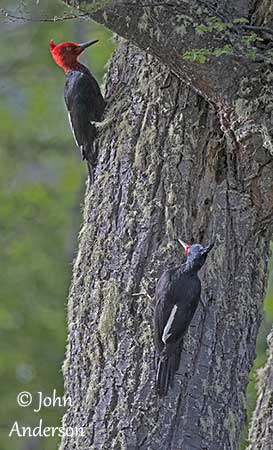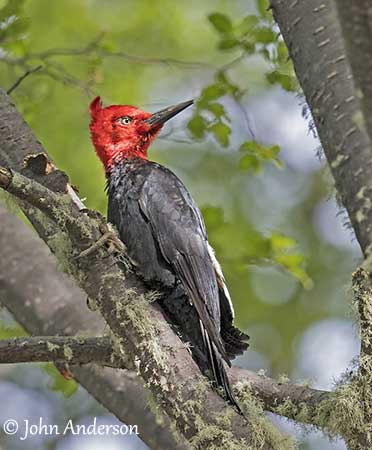
Fr: Pic de Magellan
Ang: Magellanic Woodpecker
All: Magellanspecht
Esp: Picamaderos de Magallanes
Ita: Picchio di Magellano
Nd: Magelhaenspecht
Sd: magellanspett
Photographers:
John Anderson
John Anderson Photo Galleries
Otto Plantema
Trips around the world
Text by Nicole Bouglouan
Sources:
HANDBOOK OF THE BIRDS OF THE WORLD Vol. 7 by Josep del Hoyo-Andrew Elliott-Jordi Sargatal – Lynx Edicions – ISBN: 8487334377
Woodpeckers of the World: The Complete Guide by Gerard Gorman – Editeur: A&C Black, 2014 – Helm Photographic Guides - ISBN: 1408147173, 9781408147177
WOODPECKERS, an identification guide of the woodpeckers of the world by Winkler Hans and Christie David – Helm – ISBN: 0395720435
Wikipedia, the free encyclopaedia
Neotropical Birds – Cornell Lab of Ornithology
The ecology of largest South American woodpecker in the world’s southernmost forests
SORA - The habits and relationships of the Magellanic Woodpecker
Division of labour in parental care in the Magellanic Woodpecker
Magellanic Woodpecker
Campephilus magellanicus
Piciformes Order – Picidae family
INTRODUCTION:
The woodpeckers of genus Campephilus are large, black Picidae confined to the Americas. The Magellanic Woodpecker is endemic of the austral temperate forest of Chile and Argentina, and this species is the largest of South America. The sexual dimorphism between male and female is clearly apparent.
It feeds on grubs and beetles found in mosses and lichens covering the tree trunks. It is very agile while foraging, despite its large size. Like other Picidae, it excavates a nest-hole in large tree and both mates share the nesting duties.
The Magellanic Woodpecker is vulnerable to fragmentation of the forest, involving reduction of suitable habitat, but the species occurs in several protected areas and it is not currently globally threatened.

DESCRIPTION OF THE BIRD:
Biometrics:
Length: 36-38 cm
Weight: M: 312-363 g – F: 276-312 g
The Magellanic Woodpecker adult male has glossy black to blackish-brown plumage, usually browner on the underparts. On the upperwings, the bases of inner webs of primaries are white, like on tertials’s inner webs, but they are broader on the latter. The primaries also show small white tips and we can see a narrow white area in the alula region. The uppertail-coverts, and occasionally the rump, show white streaks.
The worn plumage is duller and less glossy.
The entire head is red, including the long, recurved crest. On ear-coverts, crown and throat, some black and white bars are visible at feather bases, and become more conspicuous in worn plumage.
The long bill is blue-grey to blackish-grey. It is chisel-tipped with slightly curved culmen, broader near the nostrils. The eyes are yellow with mostly golden outer ring and grey orbital ring. Legs and feet are dark grey.
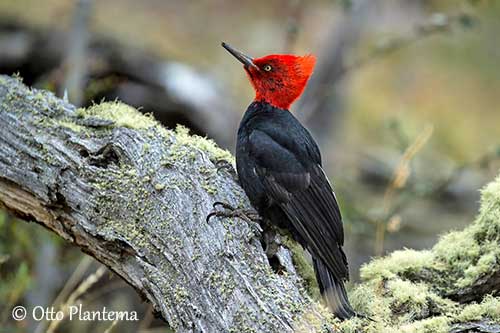
The adult female is slightly smaller with shorter bill. The narrow crest is longer and recurved. The head is black with small red area around the base of the bill.
The juvenile resembles female but it is duller and browner, and the crest is smaller. The young male shows scattered reddish tips on the head.
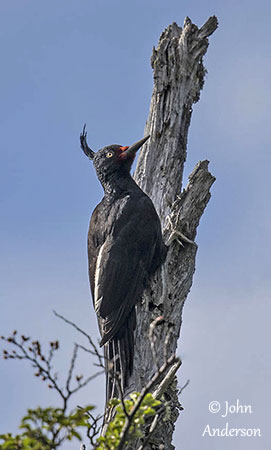
RANGE:
The Magellanic Woodpecker is the southernmost distributed woodpecker. It is present across the Andes of Chile, SW Argentina and Tierra del Fuego Island.
HABITAT:
The Magellanic Woodpecker frequents old growth and undisturbed forests, especially Nothofagus forest and mixed Nothofagus/Cupressus forest, usually with bamboo undergrowth.
These forests offer luxuriant coast of mosses and lichens, very suitable for the preferred prey of this species. It may visit more open woodland too. It is visible from sea-level up to 2,000 metres of elevation.
CALLS AND SONGS: SOUNDS BY XENO-CANTO
The Magellanic Woodpecker is often detected by a loud, double drum “ta-dap” usually heard over long distance. We can also hear various nasal, soft, loud notes “pi-caa” and “keé-yew”, or 1-3 “toot” notes, and a long “cray-cra-cra-cra-cra” given by a bird clinging to a tree before to fly off.
Both male and female drum, the male more frequently whereas the female produces shorter drum.
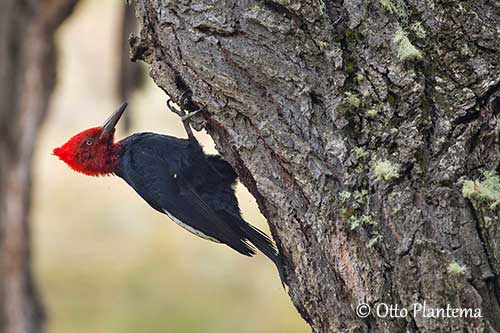
BEHAVIOUR IN THE WILD:
The Magellanic Woodpecker feeds mainly on wood-boring grubs, beetles and spiders found in dead trees. It probes the thick coat of mosses and lichens to find prey. It usually starts at half the height of a tree, and moves up from there while looking for prey.
They often forage in pairs or small groups. They are very agile and active, able to cling easily, almost like tits. They may remove the bark and create deep excavations.
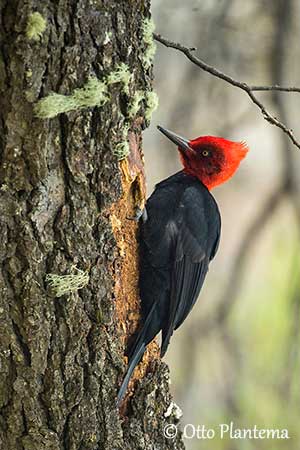
The Magellanic Woodpecker is monogamous and both adults share the nesting duties. They nest in holes excavated by both adults in dead trees. They are territorial and strongly defend both the territory and the nest-site.
During the breeding season, some displays are reported. Drummings are used as sound signals and to advertise their presence. At the beginning of the breeding season, aggressive encounters may occur around nest-sites, at roosts or close to food stores, involving vocalizations, wing-flicking and swinging movements of both head and body. Bill and feet are used in close combat and the opponents often fall to the ground during the action.
During the courtship displays, the crest feathers are raised, the head is extended and the tail is spread. The displaying bird may also droop the wings and engage in swinging movements of head and body. Aerial displays also occur accompanied by squeaky calls. Copulation usually occurs on more or less horizontal branches, and is often followed by preening by both mates.
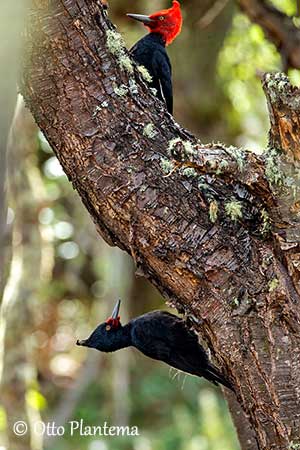
The Magellanic Woodpecker is resident.
The flight is typically undulating.
REPRODUCTION OF THIS SPECIES:
The breeding season takes place from October to January.
The Magellanic Woodpecker often excavates the nesting cavity in dead tree, between 5 and 15 metres above the ground. The shape may vary from almost circular to oval or droplet-like. This cavity may reach up to 40 centimetres deep. The bottom is sparsely lined with a small amount of sawdust or wood chips.
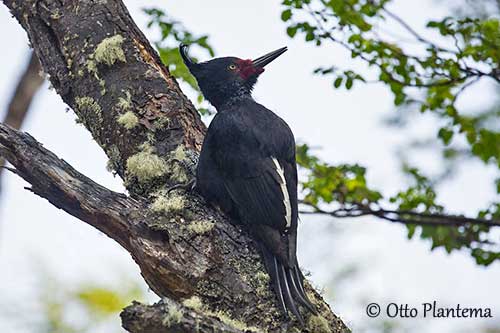
The female lays 1-4 eggs, but most nests contain only two eggs. The incubation lasts 17-20 days by both adults, the male mainly at night. The younger of the two nestlings often dies from starvation within two days. Male and female feed the chick. The young fledges 45 days after hatching. It remains in the family group for up to two years or more, until the pair begins the next reproductive cycle. They normally breed every second year.
PROTECTION / THREATS / STATUS:
The Magellanic Woodpecker is threatened by loss of forest habitats and fragmentation of temperate forests at increasing rate. The distribution of this species has contracted due to clearance of native forest in SC Chile, where this woodpecker is now restricted to relict and protected areas.
This species is described as “uncommon” throughout the range, and the population is suspected to be declining due to habitat loss.
However, the Magellanic Woodpecker is not considered globally threatened, and currently evaluated as Least Concern.
